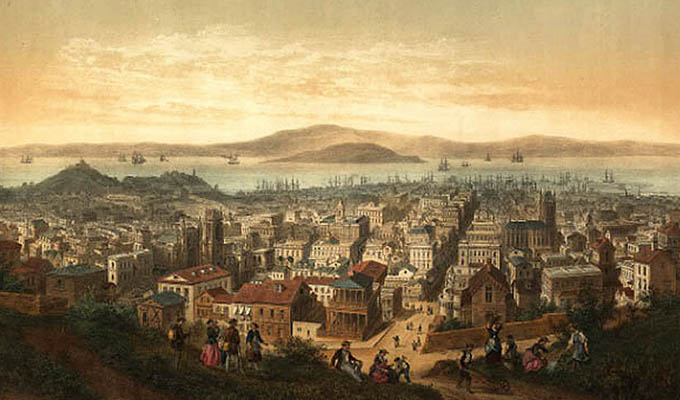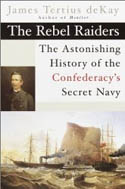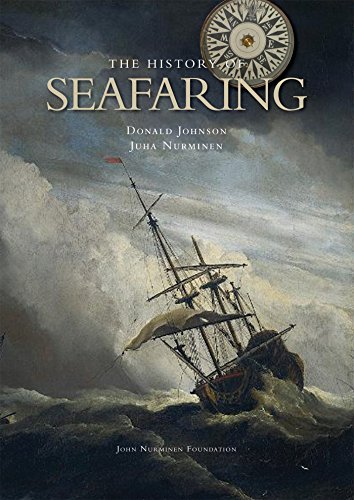Sea Captains: San Francisco 1800s
Charles Harrington MacLeod
From Captain MacLeod's family:
Captain Charles Harrington MacLeod was a well known figure in the last half of the 19th century in San Francisco and Oakland harbors.

His brother-in-law Captain W. G. Dowling and his brother Captain William MacLeod were also based in San Francisco harbor at the same time.
Captains Charlie and Will are buried in the same grave in Evergreen Cemetery in Oakland, California.
All three were from Cape Breton, Nova Scotia. Captain Charlie's son, Captain John Daniel MacLeod, settled in Oakland around 1900 after having served in the U. S. Marines including being in Admiral Dewey's fleet that sailed into Manila Bay in the Spanish American War.
Following is an obituary for Captain Charlie from the Pictou Advocate. There are more than a few errors in the text mostly misspellings of family member's names but it lays out the facts well enough. As time permits, I will try to get more information on the other Captains in my family, but it is hard to gather much from this distance. Captain Will's last command was the John Ena, a four masted clipper. A picture of this ship is in the possession of a family member in Western Canada and is printed in a book of reminiscences of Captain David Alexander MacLeod published by Cape Breton Books, Wreak Cove, Cape Breton Island. Captain Charlie and Captain Will are also pictured.
From The Pictou Advocate, 4 Mar 1911, p. 10
Capt. Charles H. McLeod
In last week's Advocate mention was made of the death of Capt. Charles McLeod, of Oakland, which took place so suddenly on the 10th Feb. The facts of the case are as follows:
Capt. McLeod had spent the night on his steamer, the Costa Rica, which was then in port, and about 9 o'clock Friday morning started to row ashore in the Captain's boat. Finding the water too rough he returned to the steamer. As he was tying the boat, his brother, Capt. Will McLeod, (who was also just boarding his vessel, which was anchored quite near) waved his hand, which salutation Capt. Charlie responded to in like manner. He tied his boat and as he stepped back, he dropped dead in the bottom of the boat. As Capt. Will gained the deck of his vessel he looked back for his brother, and noticed something lying in the bottom of the boat. On using his glass he could discern his brother's face turned up to the sky. As quickly as possible, he with others, rowed to the boat side, to find the "Grim Messenger death" had been there ahead of them.
They immediately took the body ashore and telephoned for the captain's wife, also for doctors, although they felt there was no hope. All that medical skill could do was of no avail and the remains were then prepared for burial and placed in state in the Masonic parlors.
The funeral took place on Monday afternoon, Feb. 13, at 2 o'clock, and was conducted under the auspices of "Richmond Lodge," A. F. and A. M., of which the deceased was an honored member. Besides the lodge members and immediate relatives and friends, there were present about 50 sea captains, who came to pay their respects to one of their number, who had taken his last voyage to that country from which no traveller returns.
The floral offerings were many and beautiful and the anchor of white roses, given by his wife and family, was buried with him, interment being made in Evergreen Cemetery, San Francisco.
He was about 76 years of age, and leaves a widow and seven children, Daniel J; George, William J., Hannah M., Annie J., James and Charles, to mourn their loss. The brothers and sisters who survive are as follows: John George McLeod, of New York, Mrs. (Capt.) W. T. Dowling, Mrs. R. R. Patt, and Capt. Will J. McLeod, San Francisco; Mrs. Clark, of Seattle; Mrs. Annie Bartlett, Miss Christina, David A., and John McLeod, of Cape Breton.
Mrs. Capt. Charles McLeod is the only daughter of Mr. James McLeod, of White Hill, Pictou Co.

The Authority to Sail: The History of U.S. Maritime Licenses and Seamen's Papers
Robert Stanley Bates, George Marsh (Editor), John F. Whiteley (Forward)
(Batek Marine Publishing, 2011; Nominated in 2012 for a Pulitzer Prize)
This book depicts important aspects of our maritime history never before addressed. This synthesis of key elements of our rich maritime history might never have occurred without the many years of original research done by the author, Commodore Bates, the holder of an unlimited master's license who has enjoyed a distinguished fifty-year career in both the Coast Guard and the American Merchant Marine.

Before the Wind: The Memoir of an American Sea Captain, 1808-1833
Charles Tyng
Tyng (1801-1879), who rose from cabin boy to captain and prosperous merchant, wrote this account of his early sailing days in later life. In 1996, this memoir was found by his great-great-granddaughter, Susan Fels, who edited the 419-page handwritten manuscript. An unruly boy sent to live in various homes by his rather forbidding father, Tyng first shipped on a merchant vessel at the age of 13. He hated it. But he loved his second voyage and soon became one of the youngest captains in the American merchant fleet. As Tyng tells of voyages around the world carrying cargoes of bullion, tea, linseed oil, molasses and other items to Holland, China, Cuba and other destinations, he writes with understatement, modesty and a deadpan humor that might or might not be intentional.
Tales of the Seven Seas:
The Escapades of Captain Dynamite Johnny O'Brien
Dennis M. Powers
Captain Dynamite Johnny O'Brien sailed the seven seas for over sixty years, starting in the late 1860s in India and ending in 1930 on the U.S. West Coast. He sailed every type of ship imaginable, but this book is more than the story of Captain O'Brien's incredible feats. Tales of the Seven Seas is about sailing where danger and adventure coexists on a daily basis. Smell the salt in the air and hear the ocean's rush as a ship plows its way through heavy seas with hardened men, leaking seams, and shrieking winds. These true stories are about tough times and courageous men in distant places, from the Hawaiian Islands to the Bering Sea, from the waning days of sail to the age of steamships.

The Life and Times of Georgetown Sea Captain Abram Jones Slocum, 1861-1914
Robert McAlister
Born at sea on his father's whaling ship in 1861, Captain Slocum learned the seafaring life in New Bedford, Massachusetts as part of the last generation of iron men aboard commercial wooden sailing ships in the Atlantic. His voyages often took him around Cape Hatteras to Georgetown, South Carolina, to load lumber bound for northern cities. He sailed in all seasons, through storms and hurricanes, for twenty years as captain of two schooners, the Warren B. Potter and the City of Georgetown. He was respected in Georgetown, where he wooed his wife. His ship sank in a collision with an ocean liner in 1913, but he survived, only to be lost at sea a year later as captain of another schooner.
The Sea Chart: The Illustrated History of Nautical Maps and Navigational Charts
John Blake
The sea chart was one of the key tools by which ships of trade, transport and conquest navigated their course across the oceans. John Blake looks at the history and development of the chart and the related nautical map, in both scientific and aesthetic terms, as a means of safe and accurate seaborne navigation. This handsome work contains 150 color illustrations including the earliest charts of the Mediterranean made by thirteenth-century Italian merchant adventurers, as well as eighteenth-century charts that became strategic naval and commercial requirements and led to Cook's voyages in the Pacific, the search for the Northwest Passage, and races to the Arctic and Antarctic.
The Rebel Raiders
The Astonishing History of the Confederacy's Secret Navy

James T. deKay
During its construction in Liverpool, the ship was known as Number 290. When it was finally unleashed as the CSS Alabama, the Confederate gunship triggered the last great military campaign of the Civil War; yet another infamous example of British political treachery; and the largest retribution settlement ever negotiated by an international tribunal: $15,500,000 in gold paid by Britain to the United States. This riveting true story of the Anglo-Confederate alliance that led to the creation of a Southern navy illuminates the dramatic and crucial global impact of the American Civil War. Like most things in the War between the States, it started over cotton: Lincoln's naval blockade prevented the South from exporting their prize commodity to England. In response, the Confederacy came up with a plan to divert the North's vessels and open the waterways, a plan that would mean covertly building a navy in Britain with a cast of clandestine characters.
The History of Seafaring: Navigating the World's Oceans

Donald Johnson and Juha Nurminen
Royal prestige, intellectual curiosity, and territorial expansion all propelled mankind to undertake perilous voyages across unpredictable oceans. This large and lavishly illustrated volume brings that history to life. From the early Phoenician navigation techniques to the technologies behind today's mega-ships, the greatest advances in shipbuilding are covered, accompanied by hundreds of images, with an in-depth look at navigational instruments (including those used by the Vikings).
The Authority to Sail: The History of U.S. Maritime Licenses and Seamen's Papers
Robert Stanley Bates, George Marsh (Editor), John F. Whiteley (Forward) (Batek Marine Publishing, 2011; Nominated in 2012 for a Pulitzer Prize)
This book depicts important aspects of our maritime history as a result of original research done by the author, Commodore Bates, the holder of an unlimited master's license who has enjoyed a distinguished fifty-year career in both the Coast Guard and the American Merchant Marine.
The U.S. Coast Guard issues all Captain Licenses for U.S. Ports.
Note: Other countries have different regulations, i.e. the RYA (Royal Yachting Association), conducts certification for Britain and Ireland. As of 2011, they did not recognize the USCG certification; certification through their courses was required.Master Unlimited is a licensed mariner in ultimate command of a vessel any gross tons. The captain is responsible for its safe and efficient operation, including cargo operations, navigation, crew management and ensuring that the vessel complies with local and international laws. All persons on board, including officers and crew, other shipboard staff members, passengers, guests and pilots, are under the captain's authority and are his or her ultimate responsibility. The STCW defines the Master as Person having command of the ship.
The Sea Chart
The Illustrated History of Nautical Maps and Navigational Charts
John Blake
The sea chart was one of the key tools by which ships of trade, transport and conquest navigated their course across the oceans. Herein is a history and development of the chart and the related nautical map, in both scientific and aesthetic terms, as a means of safe and accurate seaborne navigation. 150 color illustrations including the earliest charts of the Mediterranean made by 13th-century Italian merchant adventurers, as well as 18th-century charts that became strategic naval and commercial requirements and led to Cook's voyages in the Pacific, the search for the Northwest Passage, and races to the Arctic and Antarctic.
Get Your Captain's License. Fifth Edition
Charlie Wing
Considered the quickest, easiest, and least expensive way to prepare for the U.S. Coast Guard captain's ratings exams required for anyone who takes paying passengers on a boat, and useful for serious boaters who want to save money on insurance. 350 pages of seamanship and navigation tutorials. More than 1,500 questions and answers from the Coast Guard exams. Includes an interactive CD-ROM with all 14,000 questions and answers in the USCG database, so you can take an unlimited number of practice exams











 Copyright ~ 1998-2018.
Copyright ~ 1998-2018. 